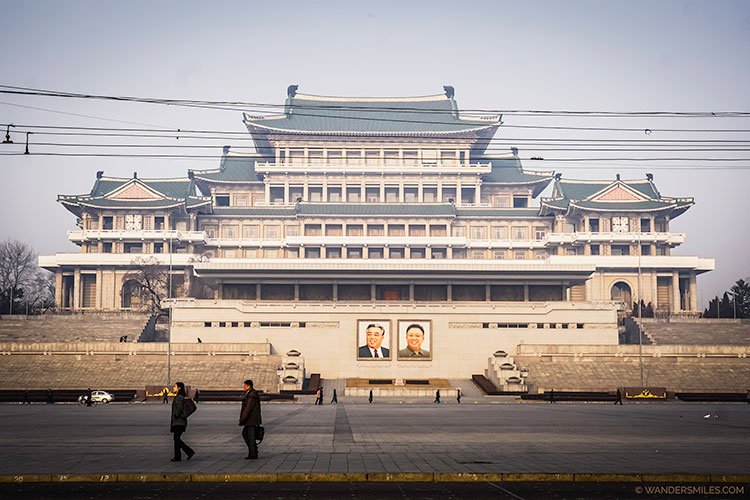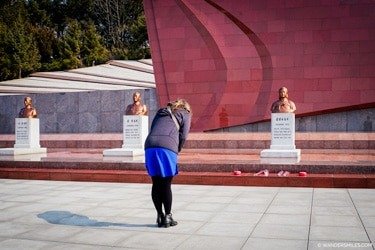14 Top Things to See in Pyongyang | North Korea
Pyongyang, the capital city of the Democratic People’s Republic of Korea (North Korea), is a unique and fascinating place. The main things to see in Pyongyang are showcasing the history of the Workers’ Party of Korea, the conquests of the supreme leaders, Kim Il Sung and Kim Jong Il, and their desire for reunification with South Korea. There’s more to it than this but let’s save that for another blog!

Things to see in Pyongyang
Juche Tower
The Juche Tower is situated on the east bank of the River Taedong in Pyongyang, directly opposite Kim Il-sung Square on the west bank. It was built to commemorate Kim Il-sung’s 70th birthday. At the entrance you can see 82 friendship plaques from foreign supporters and Juche study groups.
The Arch Of Triumph
The Arch of Triumph, built in 1982, commemorates the Korean resistance to Japan from 1925 to 1945. After national liberation in 1945 from Japanese colonial rule, President Kim Il Sung returned home and delivered a triumphant speech to the Korean people and The Arch of Triumph was built close to this place.
The mosaic of this momentous occasion in 1945 when he said everyone should be involved in building a new country. Our guide told us that Kim Il Sung announced “The rich should dedicate their money, the strong should dedicate their strength and the wise should dedicate their knowledge.”
Arch Of Reunification
The Arch of Reunification (or Monument to the Three Charters for National Reunification), opened in August 2001, is located at the southern entrance to Tongil Street in Pyongyang. It symbolises the potential unity between two countries, North and South Korea. Towering over the highway, the grand arch represents twin sisters holding a sphere with a map of the unified Koreas, and has served as the representation of the nations’ dream to become one democratically governed ‘Koryo Federation.’
The 3 Principles of National Reunification will be achieved
- without the involvement of foreign powers
- without the involvement of war and
- with the will and participation of the whole Korean Nation

Monument To Party Founding
The Monument to Party Founding was erected in October 1995 (Juche 84) at Munsu Street to celebrate the 50th anniversary of the founding of the Workers’ Party of Korea hence why the monument is 50m tall. Built on the instruction of Kim Jong Il, it conveys the proud history of the Workers’ Party of Korea composed of workers, farmers of ‘traditional’ communist ideology and intellectuals depicted by the hammer, sickle and brush seized by a worker, a farmer and an intellectual.
The Korean text on the surrounding circle reads; “The organisers of the victory of the Korean people and the leader of the Workers Party of Korea!” and the inner diameter of 42m reflects the year General Kim Jong Il was born (1942). The red apartments were built to represent the shape of the flags, the writing on the top essentially means ‘ever victorious’.

Mansu Hill Grand Monument
A 20 metre high giant bronze monument to Kim Il-sung and Kim Jong-il on Mansu Hill is one of the most sacred sites in North Korea. It is a collection of monuments (228 figures in total) and behind the Great Leaders is a mosaic mural portraying Mount Paektu, a mountain considered to be sacred within Korea.
On either side of the leaders, there are enormous stones with KWP flags and 228 bronze figures all standing at 5 meters high. This sculpture is symbolic of the socialist revolution and the struggle against North Korea’s imperialist enemies.
Visitors are expected to show the correct visiting etiquette by purchasing flowers to lay at the giant statues’ feet, marching in sombre line, hands by your sides, and bowing.


Taesongsan Revolutionary Martyrs’ Cemetery
Taesongsan Revolutionary Martyrs’ Cemetery is a memorial to the North Korean soldiers fighting for freedom and independence against Japanese rule. The cemetery is constructed on top of Mount Taesong, just outside Pyongyang and boasts a magnificent view of Pyongyang city if you catch it on a clear day.
Bronze busts adorn each grave but the most notorious is the grave of Kim Jong Suk, wife of Kim Il Sung and mother of Kim Jong Il, hailed as an anti-Japanese war hero, can be found at the top of the cemetery. It is etiquette to bow to her statue.
Kumsusan Palace Of The Sun
The Kumsusan Palace of the Sun is a mausoleum complex of the DPRK leaders, President Kim Il Sung and General Kim Jong Il, who lie in state. Inside separate rooms, their embalmed bodies lie presented inside climate-controlled clear glass sarcophagi for public viewing.
All visitors are required to wear formal dress, you enter through metal detectors, step across show cleaners and go through blowers to rid your clothes of dust. It is mandatory to stand in a line and bow to the leaders 3 times, once on the left, then the head, then to the right. Their most treasured possessions such as yacht, Mercedes, and even the train that Kim Jong-il died in which was presented in the same state including the document for provisions of fish to the people with his final signature on it.
The Kumsusan Palace of the Sun is open to foreign traveller only on a Thursday and Sunday morning, or on special occasions. Strictly no photography is allowed until you reach the gardens. The visit is a surreal but interesting experience.
Fatherland Liberation War Museum
The Victorious Fatherland War Museum is a large museum devoted to North Korea’s victories against its imperialist enemies. You are greeted by large bronze war figures and a huge display of American tanks, helicopters and equipment all taken down or recovered. Upon entering the main museum, photos or recording of any kind was not allowed.
The USS Pueblo is on show at the museum which was attacked and seized by the North Korean Navy in 1968. One sailor was killed in the assault and 82 were captured and held prisoner for 11 months before they were freed, their ‘confessions’ are on show inside the ship. This Cold War spy ship is the only U.S. Navy vessel being held by a foreign government.
Grand People’s Study House
The Grand People’s Study House is the national library of North Korea. It is located in the centre of Pyongyang and forms the background of Kim Il Sung Square. It took a year and 9 months to be completed and was opened in April 1982 to coincide with President Kim-Il-sung’s 70th birthday.
It is stocked with 30 million books and can accommodate 10,000 people per day. We joined an English class and the students were super excited to try out their English on a native speaker.
Pyongyang Metro
The Pyongyang Metro consists of two lines with 17 stations and is one of the deepest metros in the world, with the track reported to be 110 metres (360 ft) deep underground as it also serves as a bomb shelter. Socialist realist art such as mosaics, murals and statues can be found in the stations. Trains run every 3 to 5 minutes with 500,000 riders per day.
There are 2 main stations that tourists see although it is now possible to ride on the rest of the metro. Prosperity Station, the first stop on Line 1 is one of the larger stations and Glory Station. has chandeliers that represent the fireworks that went up after the end of the Korean War. The North Koreans can be seen at the newspaper stands looking for the latest scoop on the Trump and Kim Jong-un Summit in Vietnam.
Kimilsungia And Kimjongilia Flower Exhibition Centre
Kimilsungia is a tropical orchid strain that was presented to President Kim Il Sung as a gift during his visit to Indonesia. Kimjongilia is a begonia strain named after Kim Jong Il.
The Kimilsungia exhibition can be seen around Kim Il Sung’s birthday (Festival of the Sun) on the 15th of April. The Kimjongilia exhibition can be seen around Kim Jong Il’s birthday (Festival of the Shining Star) on the 16th of February.
Mirae Scientists Street
Mirae Scientists Street (Future Scientists Street) was formally opened in 2015 and was developed to house scientific institutions and their employees. The tallest building is the 53-story blue Mirae Unha Tower. The street is designed to emphasise Kim Jong-un’s focus on science and technology, built around the regime’s nuclear weapons development. Mirae Scientists Street was reportedly the first location where the Mirae public WiFi network was installed.

Korean People’s Army Circus
Pyongyang Circus was completed on May 1, Juche 78 (1989) so it is a fairly modern building filled with trophies in the corridors. You will be in awe of the daring trapeze and acrobatic routines, some had me hiding behind my hands as they were elegantly thrown from one side of the room to the other.
There were comedy interludes with audience participation. however, I was devastated to see a bear in one of the performances, we were not warned before the show. I’m told this does not happen in the Korea People’s Army Circus.

Performances By The Socialist Women’s Union
Every morning the workers are encouraged and motivated by the beats of the Socialist Women’s Union of Korea. They performed for 2 hours and we saw different coloured uniforms around the city. These ladies were in a prime spot in front of the Grand Theatre where revolutionary operas and dances are performed.
The Socialist Women’s Union of Korea is the oldest and one of the most important mass organisations in DPRK. Membership has been restricted to those women who are not members of any other mass organisation. As a result, Union members are effectively composed of women who do not work outside of the home. Women between the ages of 31 and 60 are eligible for membership, although if a woman marries and becomes a housewife, she is eligible regardless of age.

PIN FOR YOUR TRAVELS TO PYONGYANG!
Disclosure: This post contains affiliate links, which means I may receive a small commission if you click a link and purchase something that I’ve recommended. It comes at no cost to you. Thank you for your support.




























Such a historical detailed blog post on Korea! I would love to visit there someday. I would be interested to seeing the army circus and watching their creative talents.
There’s so much history that I learnt through being there and my own research. It was a fascinating trip for sure!
Such a fascinating place and history! Not sure if I’ll ever visit but interesting read and nice to see so many photos, thanks for sharing.
It was fascinating and I’m glad to have experienced it, very different to any other country I have been to for obvious reasons.
Hmmn…I wouldn’t go even if paid to.What you didn’t mention was that you had a state guide telling you hat to take photos of and showing you “tourist approved” spots to take photos of. The citizens you obviously saw you couldn’t speak to freely. I could go on… What a very stark and dry city!
Totally agree, you are shown what the guides permit you to see! My next post will be more about the dos and donts but this was more showing the history of some of the monuments in Pyongyang.
Great photos of Pyongyang! I didn’t even realize you can travel to North Korea. How were you able to visit? Did you need a visa?
You can only travel with state-owned tours, you get a minimum of 2 guides per group and the visas are issued by companies in Beijing. The guides stay with you the whole time, even stay in the hotel, no wandering off of your own. Very different to any other country I’ve visited.
Your pictures are very pretty and you put a positive spin on a controversial place. It is our history and I appreciate your post showing the area and teaching some about the history of North Korea. I, myself, would not want to visit the area, but I like to see how it looks and learn more about it. I guess that is what I am trying to say. I look forward to hearing more from you.
I wanted this post to be more factual about the monuments and the history behind them. Many people prefer to not go but I’m curious to see places for myself. There will be more coming!
Very interesting to see some of these places. Is it worth all the effort it takes to travel there?
I’m glad I visited. It’s like a step back in time really and it’s quite an experience on so many levels.
North Korea always remains a mystery to the outside world. We have different notions for the same. Your article provides a clear insight on the country and tourism points.
It really is the epitome of the hermit kingdom but the mystery isn’t fully unravelled with such a guarded visit.
I haven’t been to any place in Korea yet, but it has perpetually been in my dream country to visit. I love that you were able to divvy up with us all the historical places in Korea. The Arch of Triumph is something I should not miss to explore if I get the opportunity.
I’ve still to see South Korea to feel the contrast. There will be more blogs to come from places outside Pyongyang… watch this space!
Visiting Korea is so on my bucket list. I am glad to be reading about Pyongyang. It has such a great history. I will certainly add this place to my itinerary for Korea. The pictures are amazing too! Can’t wait to explore Pyongyang soon. Thank you for sharing!
Thank you so much, glad you liked the blog and photos. It’s a surreal experience but one I’m happy I did, I hope you make the trip.
It’s always been my dream to visit North Korea, however, I’ve never found affordable tours. I heard Chinese travel agencies tend to charge a lot less but I don’t know if they’ll process foreign passports. I really hope I’ll be able to go soon.
Ours were organised from Beijing and the passports in my group were from all over. Visiting North Korea is a surreal trip but one I’m glad I experienced.